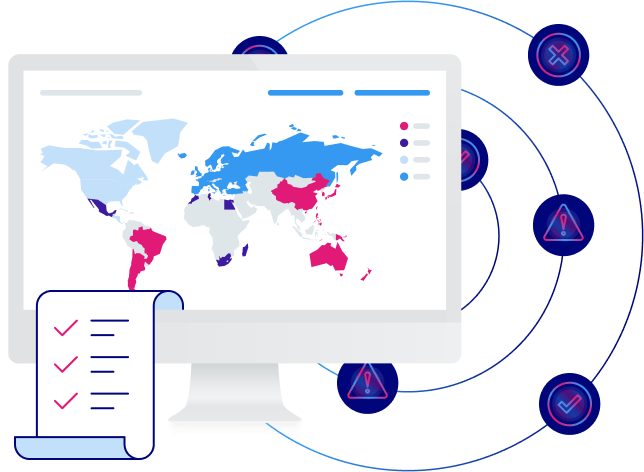-
Solutions
- AI Governance
- Geo-Specific Cookie Banner
- Consumer Preference Management
- Data Subject Request Automation
- Data Mapping and Vendor Risk Management
- Privacy, Vendor, and Risk Assessments
- Privacy Program Management
- Regulatory Guidance
- Privacy Program Consulting
- Certifications and Verifications
- International Data Transfers
Forrester TEI ROI of Privacy ReportTrustArc commissioned a Forrester study to analyze the potential benefits of using our platform and the Forrester team found ROI linked to efficiency, compliance, and decreased cost in data breaches.
Read the report -
Products Products Consent & Consumer Rights Overview
Experience automated privacy solutions that simplify compliance, minimize risk, and enhance customer trust across your digital landscape.
- Cookie Consent Manager Effortlessly manage cookie consent for global compliance, ensuring a secure, personalized browsing experience.
- Consent & Preference Manager Easily manage customer consent across brands and platforms—email, mobile, advertising—with a centralized repository.
- Individual Rights Manager Automate and streamline DSR workflows to ensure compliance and show your commitment to customer rights.
Products Privacy & Data Governance OverviewSimplify privacy management. Stay ahead of regulations. Ensure data governance with cutting-edge solutions.
- PrivacyCentral Centralize privacy tasks, automate your program, and seamlessly align with laws and regulations.
- Data Inventory Hub and Risk Profile Gain full visibility and control of your data and accurately identify and mitigate risks.
- Assessment Manager Automate and score privacy assessments like PIAs and AI Risk, streamlining your compliance workflow.
- Nymity Research Get instant access to the latest in privacy regulations, legal summaries, and operational templates.
Products Assurance & Certifications OverviewBoost brand trust with TRUSTe's certifications, showing your privacy commitment with the most recognizable seal, assessed by unbiased experts.
- Dispute Resolution
- TRUSTe Enterprise Privacy Certification
- TRUSTe EDAA Privacy Certification
- TRUSTe APEC CBPR and PRP Certification
- TRUSTe Data Collection Certification
- CCPA/CPRA Validation
- Data Privacy Framework Verification
- GDPR Validation
- Digital Advertising Alliance Validation
- Responsible AI Certification
-
Regulations
- EU General Data Protection Regulation (GDPR)
- California Consumer Privacy Act (CCPA)
- Virginia Consumer Data Protection Act (CDPA)
- NIST AI Framework
- ISO/IEC 27001
Data Privacy Framework (DPF)Transatlantic data transfer mechanism for EU-U.S., UK, and Swiss-U.S. commerce.
Learn more - Resources
- Contact us
Main Menu
Standard
The National Institute of Standards and Technology (NIST) Artificial Intelligence Risk Management
The NIST AI Risk Management Framework (RMF) is designed to equip organizations and individuals with approaches that increase the trustworthiness of AI systems, and to help foster the responsible design, development, deployment, and use of AI systems over time.
Are you subject to the AI RMF?
The NIST AI RMF is a voluntary framework that can be used by any organization or entity that develops, deploys, or operates AI systems. This includes government agencies, private companies, research institutions, and any other entities involved in AI development and deployment.
Areas of the AI RMF
Govern function
- Establishes a risk management culture within organizations dealing with AI systems;
- Develops processes to anticipate, identify, and manage risks associated with AI, considering users and societal impacts;
- Includes procedures for assessing potential impacts of AI systems;
- Aligns AI risk management with organizational principles and strategic priorities;
- Integrates technical AI design with organizational values, fostering competencies for personnel involved; and
- Manages the entire AI product lifecycle, covering legal issues related to third-party software and data usage.
Map function
- Establishes the context to frame risks related to an AI system; and
- Enables negative risk prevention and informs decisions for
- Processes such as model management, as well as an initial decision about appropriateness or the need for an AI solution.
Measure function
- Employs quantitative, qualitative, or mixed method tools, techniques, and methodologies to analyze, benchmark, and monitor AI risk and related impacts;
- Measuring AI risks includes tracking metrics for trustworthy characteristics, social impact, and human-AI configurations; and
- Processes developed or adopted in the measure function should include rigorous software testing and performance assessment methodologies with associated measures of uncertainty, comparisons to performance benchmarks, and formalized reporting and documentation of results.
Manage function
- Entails allocating risk resources to mapped and measured risks on a regular basis;
- Eisk treatment comprises plans to respond tom recover from, and communicate about incidents or events; and
- After completing the manage function, plans for prioritizing risk and regular monitoring and improvement will be in place

Achieve compliance
-
Privacy program development and compliance management Automatically identify gaps and track compliance with PrivacyCentral for NIST, ISO, and other privacy and security standards.
-
Guidance and operational templates Stay ahead of framework changes with expert guidance, ensuring your security and privacy practices remain compliant and up to date. Operationalize quickly with expert written operational templates for sample policies, checklists, and more.
-
Mitigate risks Use the pre-built AI Risk Assessment template and automatically produce a mitigation plan using TrustArc’s Assessment Manager.

The information provided does not, and is not intended to, constitute legal advice. Instead, all information, content, and materials presented are for general informational purposes only.




